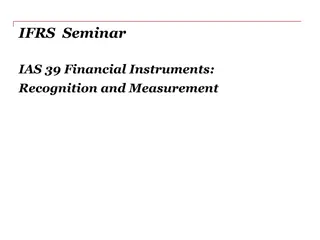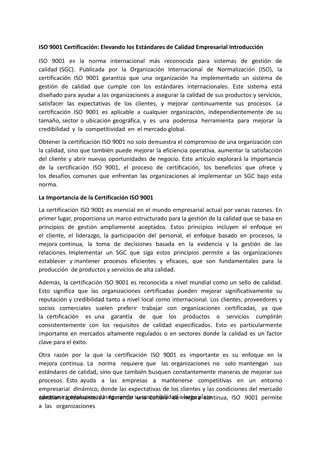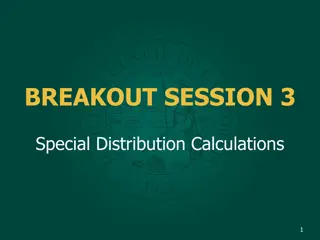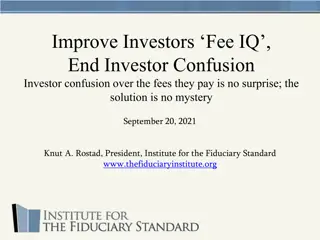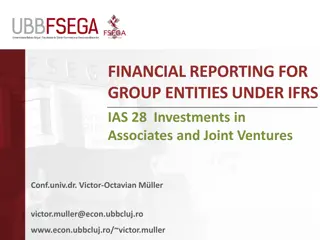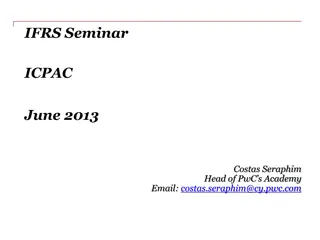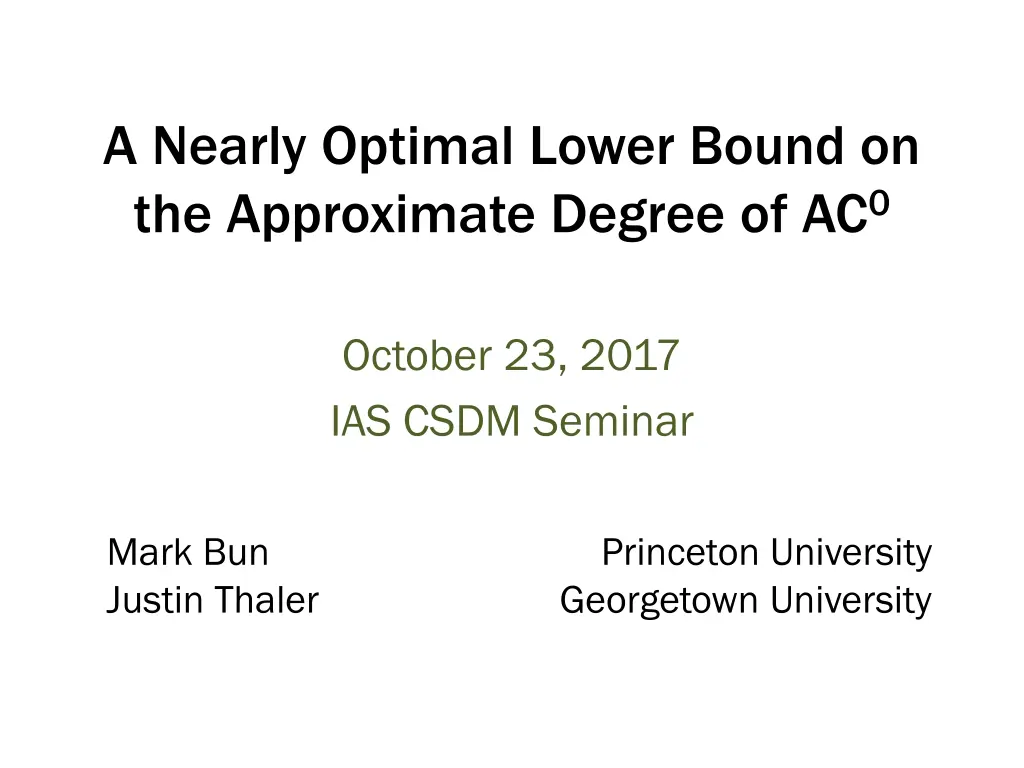
Optimal Lower Bound on Approximate Degree of AC0 Circuits
Explore the nearly optimal lower bound on the approximate degree of AC0 circuits and its significance in applications like learning algorithms, quantum query complexity, communication complexity, circuit complexity, and more. Discover how approximate degree lower bounds impact various fields within theoretical computer science.
Download Presentation

Please find below an Image/Link to download the presentation.
The content on the website is provided AS IS for your information and personal use only. It may not be sold, licensed, or shared on other websites without obtaining consent from the author. If you encounter any issues during the download, it is possible that the publisher has removed the file from their server.
You are allowed to download the files provided on this website for personal or commercial use, subject to the condition that they are used lawfully. All files are the property of their respective owners.
The content on the website is provided AS IS for your information and personal use only. It may not be sold, licensed, or shared on other websites without obtaining consent from the author.
E N D
Presentation Transcript
A Nearly Optimal Lower Bound on the Approximate Degree of AC0 October 23, 2017 IAS CSDM Seminar Mark Bun Justin Thaler Princeton University Georgetown University
Boolean Functions f : {-1, 1}n {-1, 1} where -1 = TRUE and +1 = FALSE Ex. ANDn(x) = { -1 if x = (-1)n 1 otherwise
Approximate Degree [Nisan-Szegedy92] A real polynomial p -approximates Boolean f if |p(x) f(x)| for all x {-1, 1}n deg (f) := min{d : There is a degree-d polynomial p that -approximates f} ~ deg(f) := deg1/3(f) is the approximate degree of f
Applications (Upper Bounds) Learning Algorithms = 1/3Agnostic Learning[Kalai-Klivans-Mansour-Servedio05] = 1 2-poly(n)Attribute-Efficient Learning [Klivans-Servedio06, Servedio-Tan-Thaler12] 1 PAC Learning [Klivans-Servedio03] Approximate Inclusion-Exclusion [Kahn-Linial-Samorodnitsky96, Sherstov08] Differentially Private Query Release [Thaler-Ullman-Vadhan12, Chandrasekaran-Thaler-Ullman-Wan14] Formula & Graph Complexity Lower Bounds [Tal14,16ab]
Applications (Lower Bounds) Approx. degree lower bounds lower bounds in Quantum Query Complexity [Beals-Burhman-Cleve-Mosca-deWolf98, Aaronson-Shi02] Communication Complexity [Sherstov07, Shi-Zhu07, Chattopadhyay-Ada08, Lee-Shraibman08, ] Circuit Complexity [Minsky-Papert69, Beigel93, Sherstov08] Oracle Separations [Beigel94, Bouland-Chen-Holden-Thaler-Vasudevan16] Secret Sharing Schemes [Bogdanov-Ishai-Viola-Williamson16]
Approximate Degree of AC0 AC0 = { , ,-}-circuits (with unbounded fan-in) of constant depth and polynomial size Approximate degree lower bounds underlie the best known lower bounds for AC0 under: Approximate rank / quantum comm. complexity Multiparty (quantum) comm. complexity Discrepancy / margin complexity Sign-rank / unbounded error comm. complexity Majority-of-threshold and threshold-of-majority circuit size Open Problem: What is the approximate degree of AC Open Problem: What is the approximate degree of AC0 0? ?
Approximate Degree of AC0 Prior work: Prior work: Element-Distinctness is a CNF with approximate degree (n2/3) [Aaronson-Shi02] This work: This work: Main Theorem: For every > 0, there is an AC0 circuit with approximate degree (n1- ) Depth = O(log(1/ )) Also applies to DNF of width (log n)O(log(1/ )) (with quasipolynomial size)
Applications of Main Theorem An AC0 circuit with quantum communication complexity (n1- ) Main Theorem + Pattern Matrix Method [Sherstov07] Improved secret sharing schemes with reconstruction in AC0 Main Theorem + [Bogdanov-Ishai-Viola-Williamson16] Nearly optimal separation between certificate complexity and approximate degree Main Theorem + some actual work
Roadmap Story 1: Symmetrization and the approximate degree of AND [Nisan-Szegedy92] [B.-Thaler13 Sherstov13] Story 2: Dual polynomials and the approximate degree of AND-OR Story 3: Hardness amplification in AC0 Main Theorem
Approximate Degree of ANDn ~ Theorem: deg(ANDn) = (n1/2) [Nisan-Szegedy92] Upper bound: Chebyshev polynomials Affine Transformation Td (t) Qd (t)
Approximate Degree of ANDn Theorem: deg(ANDn) = (n1/2) [Nisan-Szegedy92] ~ Upper bound: Chebyshev polynomials For d = O(n1/2): Qd (t) [2/3,4/3] for all t [0,1 1/n] Qd (1) = -1 Qd (t) Approximating polynomial: p(x) = Qd (|x|/n) = Qd (1/2 ((x1+ + xn)/2n))
Approximate Degree of ANDn Theorem: deg(ANDn) = (n1/2) [Nisan-Szegedy92] ~ Lower bound: Symmetrization[Minsky-Papert69] If |p(x) ANDn(x)| 1/3 for all x {-1, 1}n, then there exists a univariate univariateQ with deg(Q) deg(p) that looks like: Markov s Inequality: maxQ (t) (deg(Q))2 max|Q(t)| [0,1] Q (1) n/2 [0,1] (Chebyshev polynomials are the extremal case) deg(p) deg(Q) (n1/2)
Approximate Degree of ANDn Theorem: deg(ANDn) = (n1/2) [Nisan-Szegedy92] ~ Lower bound: Symmetrization[Minsky-Papert69] Symmetrization + Approximation Theory gives tight lower bounds for Symmetric Boolean functions [Paturi92] Element Distinctness [Aaronson-Shi02]
Roadmap Story 1: Symmetrization and the approximate degree of AND [Nisan-Szegedy92] [B.-Thaler13 Sherstov13] Story 2: Dual polynomials and the approximate degree of AND-OR Story 3: Hardness amplification in AC0 Main Theorem
The AND-OR Tree Define ANDn ORm : {-1, 1}nm {-1, 1} by ANDn ORm ORm x1xn ~ Theorem: deg(ANDn ORm) = (n1/2m1/2)
Approximate Degree of ANDnORm ~ Upper bound: Upper bound: deg(ANDn ORm) = O(n1/2m1/2) Quantum query algorithm [Hoyer-Mosca-deWolf03] General proof via robust polynomials [Buhrman-Newman-R hrig-deWolf03, Sherstov12] Theorem: For any functions f and g, we have deg(f g) O(deg(f) deg(g)) ~ ~ ~ Given p f and q g, is p q f g? Not in general. But p can be made robust to noise in its inputs (without increasing its degree)
Approximate Degree of ANDnORm Lower bound: Lower bound: deg(ANDn ORm) = (n1/2m1/2) ~ Symmetrization alone does not seem powerful enough [Nisan-Szegedy92, Shi01, Ambainis03] Proof via method of dual polynomials [B.-Thaler13, Sherstov13]
The Method of Dual Polynomials What is the best error to which a degree-d polynomial can approximate f? Primal LP: s.t. Dual LP: s.t.
The Method of Dual Polynomials Theorem: deg (f) >dif and only if dual polynomial such that if and only if there exists a 1. ( has L1-norm1) 2. ( has pure high degreed) 1. ( has correlation with f)
Approximate Degree of ANDnORm Lower bound: Lower bound: deg(ANDn ORm) = (n1/2m1/2) ~ Proof idea (explicit in [B.-Thaler13], implicit in [Sherstov13]) Begin with dual polynomials AND witnessing deg(ANDn) > n1/2, and OR witnessing deg(ORm) > m1/2 ~~ Combine AND with OR to obtain a dual polynomial AND-OR for ANDn ORm Uses dual block composition technique
Dual Block Composition [Shi-Zhu07, Lee09, Sherstov09] Combine dual polynomials f and g via Normalization to ensure f g has L1-norm 1 Booleanization of ( g(x1), , g(xn)) Product distribution | g| x x | g| By complementary slackness, tailored to showing optimality of robust approximations [Thaler14]
Dual Block Composition [Shi-Zhu07, Lee09, Sherstov09] Combine dual polynomials f and g via 1. f g has L1-norm 1[Sherstov09] 2. f g has pure high degree d[Sherstov09] 3. f = ANDn and g = ORm f g has high correlation with f g [B.-Thaler13, Sherstov13]
Roadmap Story 1: Symmetrization and the approximate degree of AND [Nisan-Szegedy92] [B.-Thaler13 Sherstov13] Story 2: Dual polynomials and the approximate degree of AND-OR Story 3: Hardness amplification in AC0 Main Theorem
Hardness Amplification in AC0 Theorem 1: If deg ,1/2(f) > d, then deg1/2(F) > t1/2d for F = ORt f[B.-Thaler13, Sherstov13] Theorem 2: If deg ,1/2(f) > d, then deg (F) > d for F = ORt f[B.-Thaler14] 1 2-t Theorem 3: If deg ,1/2(f) > d, then deg (F) > min{t, d} for F = ORt f[Sherstov14] Theorem 4: If deg+,1/2(f) > d, then deg (F) > d for F = ODD-MAX-BITt f[Thaler14] 1 2-t Theorem 5: If deg1/2(f) > d, then deg (F) > min{t, d} for F = APPROX-MAJt f[Bouland-Chen-Holden-Thaler-Vasudevan16]
Hardness Amplification in AC0 g Theorem Template: If fis hard to approximate by low-degree polynomials, then F = g f is even harder to approximate by low-degree polynomials 1 2-t f f 1 2-t x1 xn Block Composition Barrier Robust approximations, i.e., ~ deg(g f) O(deg(g) deg(f)) ~ ~ 1 2-t imply that block composition cannot increase approximate degree as a function of n
This Work: A New Hardness Amplification Theorem for Degree Theorem: If f: {-1, 1}n {-1, 1} is computed by a depth-k AC0 circuit, and has approximate degree d, then there exists F: {-1, 1}n polylog(n) {-1, 1} that is computed by a depth-(k+3) AC0 circuit, and has approximate degree (d2/3 n1/3) Remarks: Recursive application yields Main Theorem Analogous result for (monotone) DNF
Around the Block Composition Barrier g Prior work: Hardness amplification from the top Block composed functions f f x1 xn f g g This work: Hardness amplification from the bottom Non-block-composed functions
Case Study: SURJECTIVITY For N R, define SURJN,R: [R]N {-1, 1} by SURJN,R(s1, , sN) = -1 For every r [R], there exists an index i s.t. si = r iff Corresponds to a Boolean function on O(Nlog2R) bits Has nearly maximal quantum query complexity (R) [Beame-Machmouchi10] Exactly the outcome of hardness amplification construction applied to f = ANDR
Getting to Know SURJECTIVITY SURJN,R(s1, , sN) = -1 For every r [R], there exists an index i s.t. si = r iff ANDR Define auxiliary variables {-1 if si = r 1 otherwise ORN ORN yr,i(s) = y11 y1N yR1 yRN s1 sN Then SURJN,R(s1, , sN) = ANDR ( ORN (y11, , y1N), , ORN (yR1, , yRN) )
SURJECTIVITY Illustrated (N=6, R=3) AND3 OR6 OR6 OR6 y35 y36 y11 y12 y13 y14 y15 y16 y21 y22 y23 y24 y25 y26 y31 y32 y33 y34 (Each sj [R]) s1 s2 s3 s4 s5 s6
SURJECTIVITY Illustrated (N=6, R=3) AND3 OR6 OR6 OR6 -1 1 1 1 -1 -1 1 1 1 -1 -1 -1 1 1 1 1 1 1 2 1 2 1 3 3
Getting to Know SURJECTIVITY Observation: To approximate SURJN,R, it suffices to approximate ANDR ORN SURJN,R(s1, , sN) = -1 For every r [R], there exists an index i s.t. si = r on inputs of Hamming weight N iff ANDR Define auxiliary variables {-1 if si = r 1 otherwise ORN ORN yr,i(s) = y11 y1N yR1 yRN s1 sN Then SURJN,R(s1, , sN) = ANDR ( ORN (y11, , y1N), , ORN (yR1, , yRN) )
General Hardness Amplification Construction Natural generalization for an arbitrary f : {-1,1}R {-1,1} fR ORN ORN y11 y1N yR1 yRN F (s1, , sN) = f( ORN (y11, , y1N), , ORN (yR1, , yRN) ) s1 sN Fails dramatically for f = ORR! (F(s) identically -1)
General Hardness Amplification Construction Actual generalization for an arbitrary f : {-1,1}R/logN {-1,1} fR/ logN ANDlogN ANDlogN Fix: Force a level of alternation ORN ORN y11 y1N yR1 yRN s1 sN F (s1, , sN) = (f ANDlogN)(ORN (y11, , y1N), , ORN (yR1, , yRN))
Remainder of This Talk: Lower Bound for SURJECTIVITY
Overview of SURJECTIVITY Lower Bound Theorem: For some N = O(R), deg(SURJN,R) = (R2/3) = (deg(ANDR)2/3 R1/3) (New proof of result of [Aaronson-Shi01, Ambainis03]) ~ ~ Stage 1: Stage 1: Apply symmetrization to reduce to Builds on [Ambainis03] ~ Claim: deg(ANDR ORN) = (R2/3)even under the promise that |x| N Stage 2: Stage 2: Prove Claim via method of dual polynomials Refines AND-OR dual polynomial w/ techniques of [Razborov-Sherstov08]
Details of Stage 1 Goal: Goal: Transform p SURJN,R into q ANDR ORN for |x| N, such that deg(q) deg(p) a) Symmetrize p to obtain P which depends only on Hamming weights |y1|, , |yR|[Ambainis03] ANDR (s1, , sN) [R]N iff |y1|+ + |yR| = N ORN ORN a) Let q(x) = P(|x1|, , |xR|) yR1 yRN y11 y1N sN s1
Details of Stage 2 ~ Claim: deg(ANDR ORN) = (R2/3)even under the promisethat |x| N is equivalent to There exists a dual polynomial witnessing deg(ANDR ORN) = (R2/3)which is supported on inputs with |x| N ~ Does the dual polynomial we already constructed for ANDR ORN satisfy this property? NO NO
Fixing the AND-OR Dual Polynomial ORmust be nonzero for inputs with Hamming weight up to (N) AND-ORnonzero up to Hamming weight (RN) 1. AND-OR has L1-norm 1 2. AND-OR has pure high degree (R1/2N1/2) = (R) 3. AND-OR has high correlationwith ANDR ORN 4. AND-OR is supported on inputs with |x| N
Fixing the AND-OR Dual Polynomial ORmust be nonzero for inputs with Hamming weight up to (N) AND-ORnonzero up to Hamming weight (RN) Fix 1: Trade pure high degree of OR for support size Fix 2: Zero out high Hamming weight inputs to AND-OR
Fix 1: Trading PHD for Support Size For every integer 1 k N, there is a dual polynomial ORfor ORN which has pure high degree (k1/2) is supported on inputs of Hamming weight k k k k k k Dual polynomial AND-OR has pure high degree (R1/2 k1/2) is supported on inputs of Hamming weight kN k
Fix 2: Zeroing Out High Hamming Weight Inputs Dual polynomial AND-OR has pure high degree (R1/2 k1/2) is supported on inputs of Hamming weight kN k Suppose further that Can we post-process AND-ORto zero out inputs with Hamming weight N < |x| kN without ruining pure high degree of AND-OR correlation between AND-ORand ANDR ORN? k YES (Follows from [Razborov-Sherstov-08]) k k
Fix 2: Zeroing Out High Hamming Weight Inputs Technical Lemma (follows from [Razborov-Sherstov08]) If 0 < D < N and 2-D, then there exists a correction term corr that 1. Agrees with AND-ORinputs of Hamming weight >N 2. Has L1-norm 0.01 3. Has pure high degree D k k
Fix 2: Zeroing Out High Hamming Weight Inputs Claim: For 1 k N, Proof idea: ORcan be made weakly biased toward low Hamming weight inputs: For all t > 0, k k Worst high Hamming weight inputs look like |x1| = k, , |xR/k| = k, |x(R/k)+1| = 0, , |xR| = 0 k k k k Weight on such inputs looks like k R/k
Putting the Pieces Together Dual polynomial AND-OR Fix 1 has pure high degree (R1/2 k1/2) satisfies Correction term corr Fix 2 has pure high degree (R/k) agrees with AND-ORinputs of Hamming weight >N AND-OR= AND-OR corr has k Balanced at k = R1/3 PHD (R2/3) k k k k 1. L1-norm 1 2. high correlationwith ANDR ORN 3. pure high degree (min{R1/2k1/2, R/k}) 4. support on inputs with |x| N
Recap of SURJECTIVITY Lower Bound Theorem: For some N = O(R), deg(SURJN,R) = (R2/3) = (deg(ANDR)2/3 R1/3) (New proof of result of [Aaronson-Shi01, Ambainis03]) ~ ~ Stage 1: Stage 1: Apply symmetrization to reduce to Builds on [Ambainis03] ~ Claim: deg(ANDR ORN) = (R2/3)even under the promise that |x| N Stage 2: Stage 2: Prove Claim via method of dual polynomials Refines AND-OR dual polynomial w/ techniques of [Razborov-Sherstov08]
Conclusions I: Upcoming Work This work: New degree amplification theorem almost optimal approx. degree lower bound for AC0 Upcoming work [B.-Thaler-Kothari]: Quantitative refinement to hardness amplification theorem, with applications deg(SURJN,R) = (R3/4) Matches upper bound of Sherstov ~ Nearly tight approx. degree / quantum query lower bounds for k-distinctness, junta testing, statistical distance, entropy comparison
Conclusions II: Open Problems Is there an AC0 function with approximate degree (n)? A polynomial size DNF? Can we obtain similar bounds for close to 1? Conjecture: There exists f AC0 with deg (f) = (n1- ) even for = 1 2 n1- What is the approx. degree of APPROX-MAJ? Thank you!













